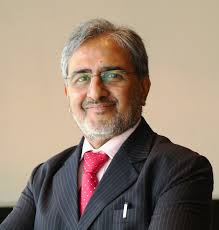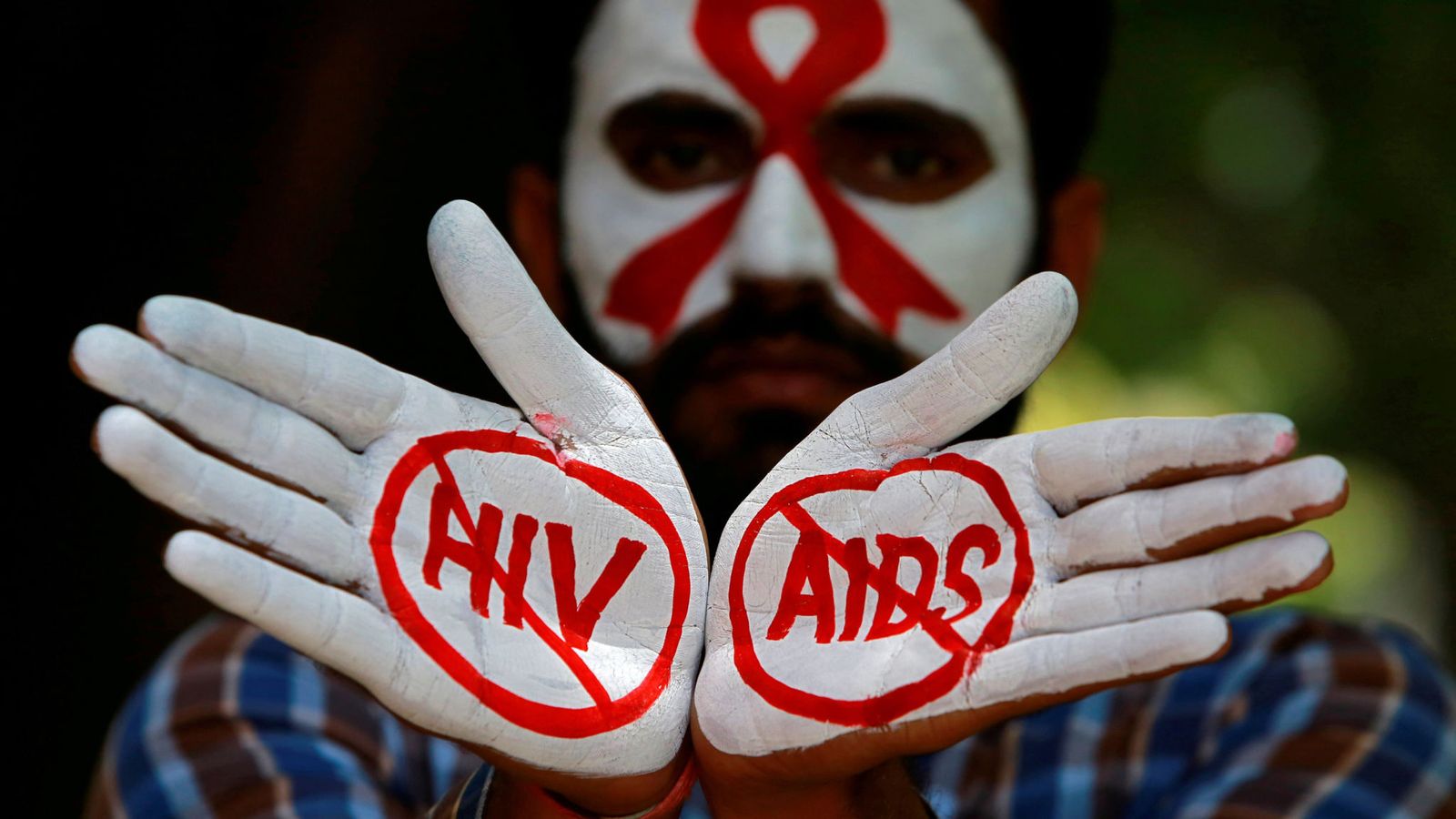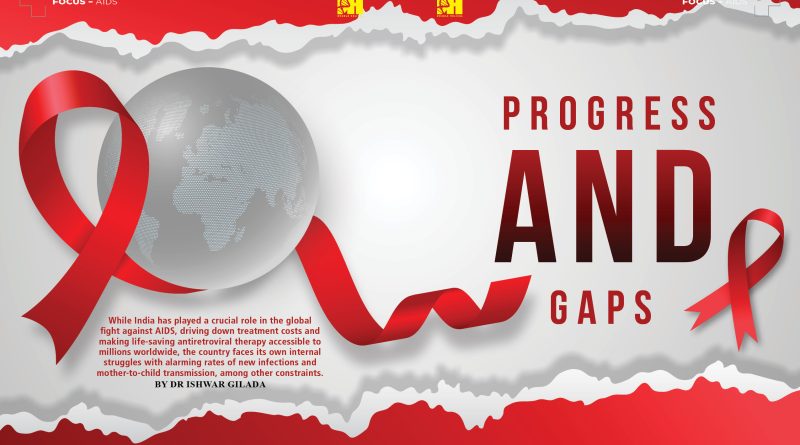Progress and Gaps
 While India has played a crucial role in the global fight against AIDS, driving down treatment costs and making life-saving antiretroviral therapy accessible to millions worldwide, the country faces its own internal struggles with alarming rates of new infections and mother-to-child transmission, among other constraints.
While India has played a crucial role in the global fight against AIDS, driving down treatment costs and making life-saving antiretroviral therapy accessible to millions worldwide, the country faces its own internal struggles with alarming rates of new infections and mother-to-child transmission, among other constraints.
By Dr Ishwar Gilada
On December 1, 2024, we commemorated the 36th World AIDS Day (WAD) under the theme “Take the rights path: My health, My right!” This theme highlights the importance of addressing inequalities that hinder progress in fighting Acquired Immunodeficiency Syndrome (AIDS) and ensuring human rights protection. The World Health Organization (WHO) urges global leaders and citizens to champion health rights as a central component of ending AIDS as a public health threat by 2030.
WAD serves as a crucial platform to assess progress and identify areas for improvement in Human Immunodeficiency Virus (HIV) prevention, control, and management. The past two decades have seen remarkable achievements, saving millions of lives globally and preventing countless new HIV infections.
However, formidable challenges remain. According to the Joint United Nations Programme on HIV/AIDS (UNAIDS), of the 39.9 million people living with HIV (PLHIV), 9.3 million (24 per cent) still lack access to life-saving antiretroviral therapy (ART). In 2023, 630,000 people died of AIDS-related illnesses, and 1.3 million people newly acquired HIV globally – the same number as the previous year. Shockingly, new HIV infections are steadily increasing in at least 28 countries.
 India’s Crucial Role in Combating AIDS
India’s Crucial Role in Combating AIDS
WAD is also an occasion to portray India as a global saviour. India has played a heroic role in normalising the AIDS pandemic. It is crucial to conduct research and development (R&D) for preventing and treating diseases, but it is even more important to ensure the fruits of R&D reach a wider humanity. And precisely that is what India has done. Today, HIV is a chronic manageable disorder, arguably even better managed than diabetes for some. The United Nations (UN), WHO, and UNAIDS, though they talk and plan big, piggybacking on India’s strength, deliberately shy away from acknowledging India’s contribution in making ART affordable and accessible to 92 per cent of PLHIV globally.
However, despite setting ambitious goals of zero new infections, zero deaths, and zero discrimination by 2030, India still has a distance to travel. Ensuring PLHIV have access to testing and treatment alongside laws and policies that combat stigma and discrimination towards them and key populations (high-risk groups) is critical. India’s HIV/AIDS Act 2017 should be actively enforced to align with the 2024 WAD theme.
Undetectable Equals Untransmittable (U=U)
While there is no cure for HIV, with effective prevention, diagnosis, treatment, and care, it has become a manageable chronic condition. ART can suppress viral load to undetectable levels within a couple of months, rendering the virus untransmittable (U=U). Every new infection represents a “missed opportunity” where prevention options could have stopped transmission. Additionally, every AIDS-related death is a reminder that we have the tools to prevent them with existing strategies. Therefore, ensuring full access to a comprehensive suite of HIV prevention, care, and support services, particularly for key populations, is vital.
Missed Opportunities and Obstacles
We possess the necessary tools to end AIDS – scientifically proven methods for prevention, diagnosis, and treatment. However, a multitude of “missed opportunities” hinder the global response. Challenges like lack of accountability, suboptimal program effectiveness, and complacency impede progress towards an AIDS-free world. The COVID-19 pandemic’s impact cannot be ignored, but excuses cannot hold us back forever. We need to accelerate action.
India had an estimated 2.54 million PLHIV in 2023 (including 70,000 children), a slight increase from previous years. Alarmingly, there were 68,450 new infections in 2023 (187 daily), and 35,870 AIDS-related deaths (four per hour) – an 11 per cent increase from 2022. Eliminating mother-to-child transmission (MTCT) of HIV is a crucial milestone, but progress remains insufficient – despite not requiring behaviour change, unlike sexual transmission. In 2023, only 64 per cent of pregnant women received medication to prevent MTCT, resulting in an MTCT rate of 11.75 per cent.
Reality Checks and Red Flags
Several red flags signal the need for prompt action in India:
High HIV Prevalence: States like Mizoram, Nagaland, Manipur, and Andhra Pradesh report widespread presence of the virus.
High percentage increase: Tripura, Arunachal Pradesh, Meghalaya, and Punjab show a worrying trend.
High Mortality: Arunachal Pradesh, Tripura, and Punjab have high death rates.
Poor MTCT Control: Andhra Pradesh, Bihar, Uttar Pradesh, Gujarat, Karnataka, Maharashtra, Punjab, and Telangana need stronger programs.
High Numbers of PLHIV: Andhra Pradesh, Gujarat, Bihar, Karnataka, Maharashtra, Tamil Nadu, and Uttar Pradesh have the highest numbers of people living with HIV.
High HIV Deaths: Andhra Pradesh, Karnataka, and Maharashtra report the highest number of HIV-related deaths.
Where Does India Lag Behind?
India’s HIV prevalence peaked in 2000 and has shown a continuous decline for the past two decades: from 0.55 per cent in 2000 to 0.32 per cent in 2010, 0.21 per cent in 2021, and 0.2 per cent in 2023. However, a resurgence in HIV is evident, with an increasing number of new infections, especially among young people, along with a rising trend in sexually transmitted infections (STIs) including human papillomavirus (HPV), hepatitis B (HBV), and syphilis.
Fortunately, syphilis is curable with affordable treatment, but faces shortages of injectable long-acting penicillin and hesitancy from some doctors to administer it. While HBV and HPV are incurable, they are fully vaccine-preventable. HBV vaccines are available at low cost but are sometimes in short supply. We cannot remain solely HIV-centric and must focus on other STIs. Data has long highlighted the low coverage of HIV services for key populations. We must scale up the HIV response for them. While overall HIV prevalence in adults in India is 0.2 per cent, it is significantly higher among key populations: sex workers (1.9 per cent), men who have sex with men (MSM) (3.3 per cent), transgender people (3.85 per cent), and people who inject drugs (PWID) (9 per cent). HIV prevalence in prisoners is 1.9 per cent, but ART coverage is only 28.7 per cent.
The Latest in the Armamentarium – Lenacapavir
Recent studies have shown that twice-yearly injectable Lenacapavir prevents 96 per cent of HIV infections. The pharmaceutical company Gilead has generously offered royalty-free voluntary licenses to four Indian generic manufacturers, and India is likely to offer it at less than US$100 annually, compared to US$44,000 from Gilead. Pre-Exposure Prophylaxis (PrEP) and HIV Self-Testing (HIVST) are not yet part of the National AIDS Control Program (NACP). Their inclusion would help prevent new infections and detect undiagnosed cases, bridging the gap in the first target – 95 per cent of people with HIV should know their status.
The Way Forward
India has a proven capacity to manufacture HIV diagnostics and medicines, and robust supply chain mechanisms to deliver them worldwide sustainably. Our HIV programs should ensure that HIV prevention, diagnostics, treatment, care, and support services reach everyone in need. The best opportunity to eliminate the difference between “what we know works” and “what we do” is now. We know how to prevent, diagnose, and treat HIV and support PLHIV. But the gap between where we are and where we need to be is a chasm we can no longer afford. We must bridge this gap to end AIDS and control other STIs. MTCT should be eliminated or nearly eliminated. New infections and deaths should be minimised. PrEP and HIVST should be introduced.
All these issues should be thoroughly discussed among stakeholders, with ongoing discussions on action plans for HIV control, with the ultimate goal of achieving zero new HIV infections, zero HIV-related deaths, and zero HIV-related discrimination by 2030, which is fast approaching.
(The author is a consultant in HIV and STIs, Secretary General of the People’s Health Organisation (PHO) and the Organised Medicine Academic Guild (OMAG); President Emeritus of the AIDS Society of India; and a Governing Council Member of the International AIDS Society)

